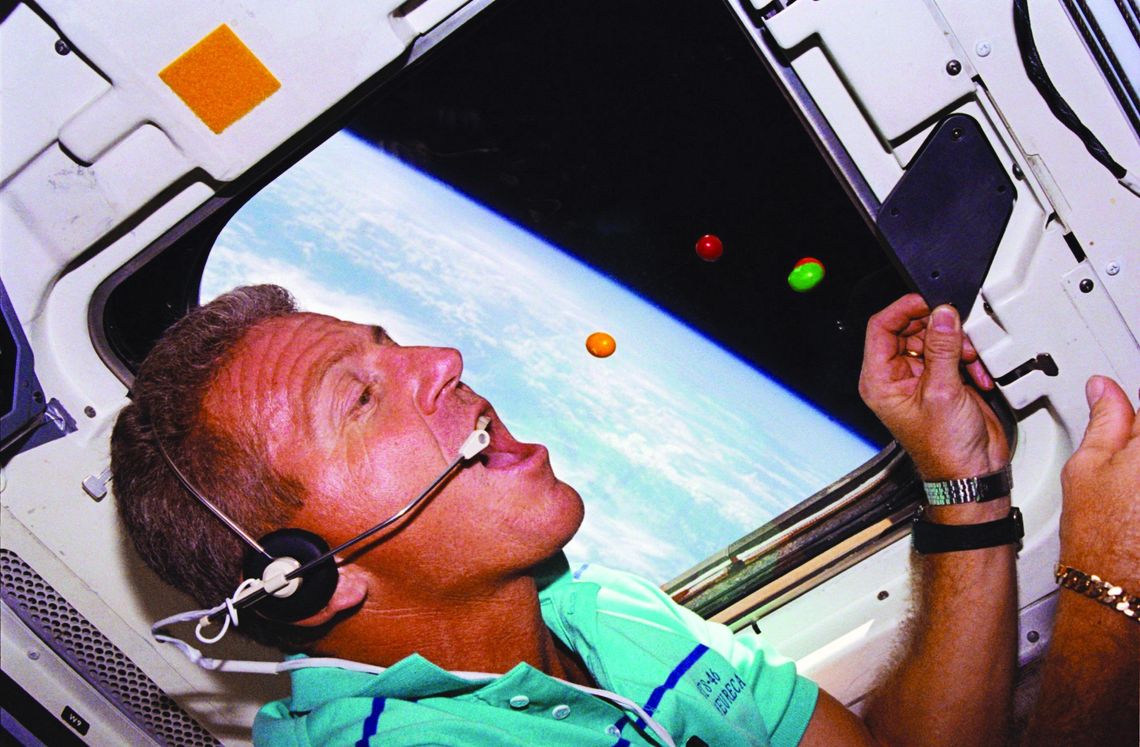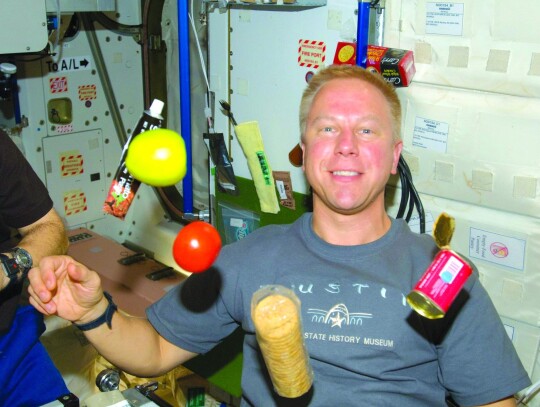When Russian cosmonaut Yuri Gagarin orbited the earth in 1961, he proved that a human could orbit the planet and survive. He also proved that humans could eat and swallow in zero gravity when he squeezed beef and liver paste into his mouth from an aluminum tube.
Since then, missions into space have expanded in every way imaginable. One of great strides forward has been the variety of foods available to astronauts and the success of overcoming the challenges of eating and working in microgravity.
Wimberley resident Mike Fohey, who spent 40 years as a contractor at the National Aeronautics and Space Administration, knows all about those challenges.
He was part of the team that prepared and packaged food for astronauts at the Space Food Systems Laboratory at the Johnson Space Center in Clear Lake, TX, before he retired in 2014.
His first major assignment was to provide quality assurance on the spoon bowl food packaging system on the first Apollo- Soyuz test project that rendezvoused with Russian cosmonauts in 1975.
When he began work at the food lab, the team consisted of Fohey, who was the sole packaging engineer; food scientists, who designed the meals; a dietician, who made sure each meal was tailored to each astronaut; and technicians who prepared and packaged the food.
No longer the meat paste of earlier U.S. Mercury missions, astronauts today can choose from an astonishing array of food items. They can eat from a standard menu, can substitute items to accommodate their own preferences, or even design their own.
They can choose from entrées like scrambled eggs, sausage patties, shrimp cocktail and beef steak; side courses like rice pilaf and broccoli with cheese; and desserts and snacks like butterscotch pudding, shortbread cookies and candy coated peanuts. Natural foods like nuts and dried fruits are also available. Fresh foods like fruits and vegetables are only available early in a mission due to shelf life concerns. Frozen and refrigerated foods are available only if there is space in cold storage lockers that are reserved for bringing back scientific samples to Earth for analysis. Beverages are generally in powder form and are rehydrated with water available as a byproduct of fuel cells on the Shuttle that can generate electricity.
Besides improving the variety of foods available, there were other hurdles to overcome. The microgravity environment affects the body’s sense of taste. Body fluids cling to tissue linings and instead of being pulled down by gravity towards our feet, they are evenly dispersed throughout the body. This leads to stuffy noses and blocked sinuses that make it hard to enjoy the aromas we normally associate with food. Like eating food with a head cold, food in microgravity can taste more bland. Astronauts report that foods normally enjoyed on Earth can taste different in space. It’s not surprising that they prefer meals that are highly spiced, with intensely sweet, salty, bitter or smoky flavors.
“One astronaut ate our shrimp cocktail for every single meal because the horseradish in the sauce cleared up his congestion,” said Fohey.
Body fluids also cling to the linings of the stomach.
“At one point, Coca Cola wanted to develop a way that astronauts could drink their product in space,” Fohey said. “They produced the zero-gravity soda can. Pepsi, not wanted to be left back on Earth, also developed a zero-g can using technology similar to a whipping cream container.” This kicked off the Cola Wars in Space. Prior to being manifested on a Shuttle flight, it was Fohey’s task, as the packaging engineer to test both containers on the NASA gravity craft, colorfully referred to as the “vomit comet.”
“Both colas were tried on the STS 51-F Mission in 1985, but never flew again,” he continued, “as the carbonation in both drinks produced a very uncomfortable reaction known as a wet belch.”
Like carbonated beverages, some foods and seasonings do not work in microgravity. Bread, for example, is not generally used because it produces crumbs that can potentially drift into sensitive electronic and mechanical systems. Likewise, granular salt, pepper and other spices can drift into the eyes of astronauts and hamper their vision. Thanks to Texas’ proximity to the food culture of Mexico, tortillas replaced slices of bread, and salt and pepper were packaged as liquids.
As the packaging expert, Fohey’s job was to find ways for space scientists to consume and swallow the foods and beverages that would sustain them, without generating too much trash.
When he joined the team in 1971, astronauts were eating meals from packages known as Apollo spoon bowls. Much more appetizing and easier to use than food tubes, rehydrated foods in the spoon bowls allowed astronauts to use a common food utensil, which made dining in space much more like eating on Earth.
“The simple act of eating food (that looked like food) with a spoon, from a bowl, became a key component of maintaining the astronauts psychological fabric and physical well-being during space travel.” Forks and knives were included along with the spoons in the Shuttle food system.
The simple act of eating food (that looked like food) with a spoon, from a bowl, became a key component of maintaining the astronauts psychological fabric and physical well-being during space travel.
— Mike Fohey,
Food packaging specialist for NASA As sojourns into space lengthened, food storage needed to be better integrated into the crew cabin design. Prior to the Shuttle, food was stored in irregularly shaped lockers and meal packets were tethered together with lanyards. The General Electric Company was tasked with developing an Integrated Food System with a galley for the Space Shuttle. As part of that effort, engineers created rigid square packages that could be easily stacked and stowed in the food lockers that were part of the Shuttle mid-deck. Fohey coordinated with the GE galley team to harmonize the square packaging so that it fit into the locker trays.
Outreach was also a part of the food lab’s mission. NASA “brass” would often invite VIPs to dine in the lab to show off the innovations they’d achieved.
One of Fohey’s favorite guests was humorist and author Erma Bombeck, from the news program Good Morning America. “She was hilarious,” said Fohey who went on to relate how cramped it was inside the Shuttle mid-deck galley area where the segment was to be filmed, especially with a camera and sound crew in tow. Astronaut Sally Ride was slated to be Bombeck’s guest on GMA and Bombeck wanted her to demonstrate how meals were prepared in space, but Ride politely declined. Food preparation was a task of everyone on board, and Ride didn’t want viewers to associate it only with the female astronauts.
Fohey saved the day by demonstrating how to heat and rehydrate the meals for the news segment.
“The camera recorded my hands,” he said, “which didn’t look at all like Sally’s and there was no mistaking my hands for hers.”
Other VIPs to visit the lab were as diverse as Minnie and Mickie Mouse and Queen Elizabeth and Prince Philip. Guest chefs also visited the lab to prepare recipes for potential meals aboard the Shuttle. Both Rachel Ray and Emeril Lagasse, for example, worked with the food scientists and lab technicians to prepare signature entrées to include in a Shuttle menu.
When preparations for the 1995 film, Apollo 13, were underway in the ‘80s, the food lab hosted the director Ron Howard and actors from the film who were preparing for their roles. On one occasion, Howard, his wife Cheryl and daughter Bryce, along with Tom Hanks and Bill Paxton, arrived for a space food breakfast and more “research” for the film.
“A few weeks later I was told that members of the Apollo 13 cast and crew were coming for lunch, but I had to keep it a secret from the rest of the staff,” said Fohey. When asked if it was difficult to do so, he laughed and said, “Well, not really. I didn’t want to have to report to the higher ups that I was the guy who spilled the beans.”
“On this occasion,” Fohey said, “Bill Paxton brought a camcorder with him to record the events of the visit.” In the prior visit, NASA Shuttle food system manager, Vickie Kloeris, described a display board that showed the kinds of foods and food packages astronauts used during space missions.
“In the style of a news interviewer, Bill Paxton asked Tom Hanks to tell “viewers” what the items displayed on the board were,” said Fohey, “and Hanks delivered Vickie’s explanation, practically word for word, that he’d heard weeks ago during the earlier visit. It made me think that an excellent memory must have helped him in his career.”
For more stories of the NASA food lab and their role in space program, check out “Space Bites: Reflections of a NASA Food Scientist” by Fohey’s former colleague and food scientist mentioned above, Vickie Kloeris. The book can be preordered at vickiekloeris.com.
With his work world behind him, Fohey is enjoying life in Wimberley with his wife, Chris Dailey, playing bridge and a little golf from time to time. Chris also enjoyed a long-time career at NASA, performing a variety of roles for the organization including the analysis of satellite images.








